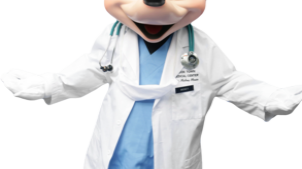It’s nothing new for hospitals to look to revered service brands like Ritz-Carlton and Disney for lessons in customer service. Many a hospital has hired one of their consultants to provide counsel on revolutionizing their patient experience program. As a mom planning a Disney World vacation, it has become even more apparent to me that hospitals could take a page from Disney when addressing wait times, which are often responsible for a negative patient experience.
Some people wait 2 – 3 hours (yes, hours) for attractions at Disney World, like meeting Frozen characters Anna and Elsa. Waiting is just part of the theme park experience. But, people (especially young ones) hate waiting…so, why does everyone have such a magical experience?
Waiting seems to be inherent in the healthcare experience, too. However, patient feedback is far more critical of hospital wait times that are often much shorter than what people are spending to meet a college student in a princess costume (we’re saving lives here, people!). Some of that is related to circumstances. No, going to the ER with a sick child is not Disney World. However, are there opportunities to inject that trademark Disney magic into a time when people need it the most?
First, a few lessons from David Maister’s The Psychology of Waiting:
1) Unoccupied time feels longer than occupied time
2) Anxiety makes waits seem longer
3) Pre-process waits seem longer than in-process waits
4) Uncertain waits feel longer than finite waits
By making the wait a part of the overall experience, Disney World is addressing all of these factors.
- The Seven Dwarfs Mine Train is the newest attraction to open in the Magic Kingdom’s new Fantasyland and the wait times reflect that. However, waiting is part of the fun as you enter a mining cave with interactive games involving jewels.
- At bus stops, an especially mundane place to wait, guests report cast members leading sing alongs and telling jokes to help pass the time.
- Parents share stories of waiting for eons to take their little one on the Dumbo the Flying Elephant ride. The new Fantasyland not only introduces a second ride, it also includes a waiting area modeled after the big top tent in the movie, where parents can enjoy air-conditioned seating and kids can take on the role of circus clowns and climb around the burning brick building, become acrobats on the swinging disc challenge, or bounce up and down the trampoline climbers.
Takeaway:
Many hospitals and physician offices have included technology such as iPads in their waiting rooms. And, it’s not uncommon to offer health education programs on television. However, is there an opportunity to elevate the waiting experience with something unique? How about health assessments for family members waiting in the surgical waiting area? Or brain-sharpening games using a tool similar to live trivia that is available at some restaurants? Perhaps a “teddy bear hospital kit” complete with a stuffed bear, play medical instruments, and a book for waiting children?
The best waiting experience is the wait that never happens. When Disney introduced FastPass in 1999, it changed the waiting game for visitors. Now, with FastPass+, visitors can reserve up to three experiences per day, offering a one hour window of time to show up to ride a hot attraction like Soarin’ or even meet Anna and Elsa. This allows them to enjoy the park while waiting for their reserved time and creates some certainty in their schedule.
Takeaway:
Hospitals commonly post their ER wait times, but why don’t hospital ERs offer an opportunity to pre-reserve a time and wait at home for non-life-threatening conditions? Or physician offices or labs offer a text notice when they can anticipate seeing a patient within 15 minutes (allowing them to walk the grounds or run a quick errand)? There are some hospitals that are pioneering this approach, but it has yet to be widely accepted.
While healthcare has specific considerations that make it more challenging to revolutionize the waiting experience, hospitals and physician offices have tremendous opportunity to take one of their greatest detractors and turn it into an asset.

